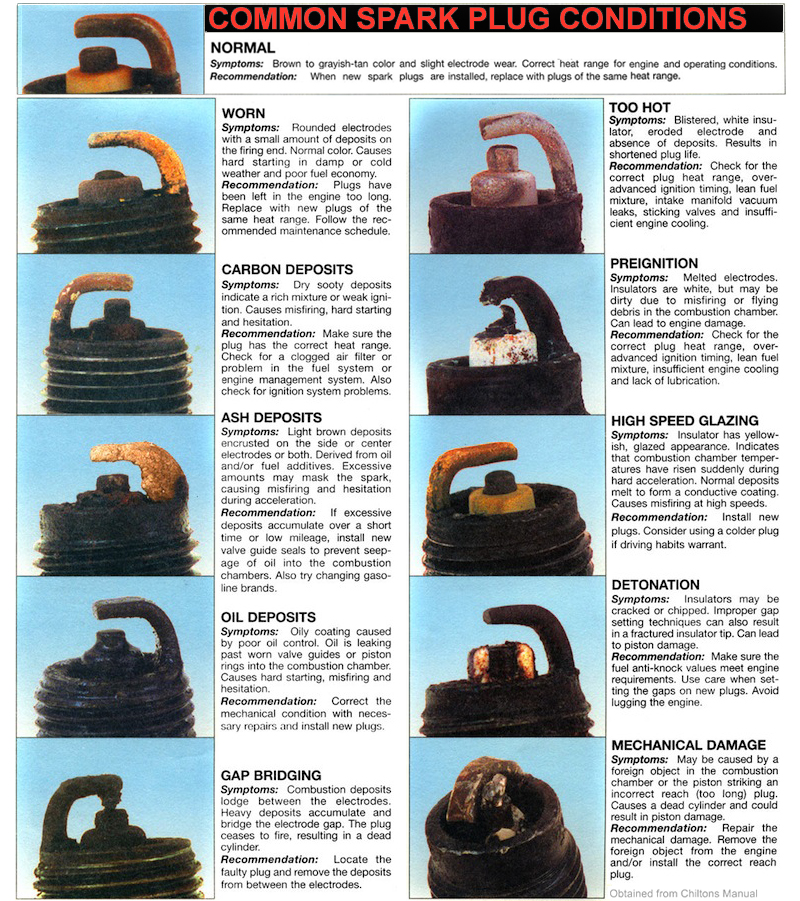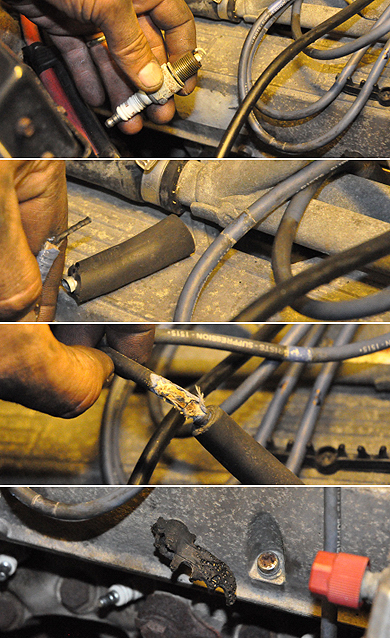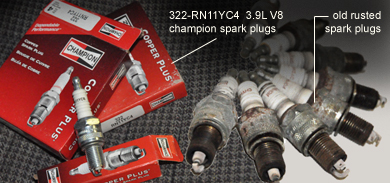 Defender 110 Spark Plugs & Plug Wires |
|
Spark plugs deliver the spark needed to ignite the air/fuel mixture in your V8 engine. Failed spark plugs prevent combustion, waist energy, increase emissions, decrease performance, cause rough idle, hesitation, hard starting and possibly even a no start if most of the plugs are affected. The spark is created when high voltage supplied by the ignition coil jumps across a small air gap between the plug electrodes. The high voltage surge from the coil goes through the plug center electrode, ionizes the air between the electrodes and forms an arc (spark) as it jumps across the air gap to the outer ground electrode. The initial voltage required to form the spark may may reach over 25,000 volts depending on the distance between the electrodes, engine load and compression. The spark only lasts about a millisecond which is long enough to start the burn process.
The spark is timed precisely to coincide with the position of the piston as it nears top dead center on its compression stroke. With the V8 patrol engine the spark occurs a few degrees before the piston reaches top dead center. If the spark occurs too soon, cylinder pressures increase too quickly and peak too early in the cycle resulting in a loss of power. This can also cause engine damage over time. If the spark occurs too late, cylinder pressures peak too late in the cycle also resulting in a loss of power. Timing is controlled by the engine control (/computer) module/unit (ECM/ECU) and ignition module, not the spark plugs, therefore a timing problem would indicate a sensor or ECM/ECU problem. Champion spark plugs are most often recommended by experts for your Defender V8 engine.
Spark plugs in your Defender V8 engine may not be the only reason for idle trouble and similar complications. The ignition wires from the distributor connected to each spark plug can also cause similar symptoms. Good plug wires are absolutely essential for reliable ignition performance and trouble-free operation. A cracked plug wire leading to cylinder eight, can cause as much trouble as a fouled spark plug on eight. For this reason when replacing spark plugs it is essential to carefully examine all plug wires, making sure they are not cracked, burnt, or corroded at either receptacles. |
A bad spark plug wire may create enough resistance to prevent voltage from reaching the plug, or a break in the insulation may cause the spark to arc to ground. Either way, a bad plug wire will cause a spark plug to misfire. SuperMag makes high performance spark wires which can be found at your local auto part stores. Fouling Spark Plug: Fouling can occur if fuel or oil deposits build upon the plug electrodes. The ceramic insulator around the center electrode prevents voltage from finding a way to the steel plug shell and ground. Fouling can be a problem if an engine uses oil. Worn valve guide seals and guides can allow oil to be sucked down the guides and into the combustion chamber. A heavy buildup of thick black deposits on the plug and intake valve would indicate such a problem. Extensive idling and/or short trip stop and go driving can also lead to quick buildup of normal fuel deposits if the plugs never get hot enough to burn off the deposits. Powdery black deposits on the plugs can occur from "carbon fouling" due to rich fuel mixture. On the NAS fuel injected engine, the problem might be a leaky injector, or a dead oxygen sensor that prevent the ECU from going into closed loop to lean out the fuel mixture. When replacing a set of plug wires always replace one wire at a time to avoid mixing up the firing order. Start with the longest plug wire(s) and go to the shortest or vice versa. If you mix up the firing order, the engine may not start or it may pop and backfire. This may damage the engine. Refer to the ignition wiring diagram if you loose track. Route the replacement wires exactly the same as the originals, supported by holders/mounts so they do not contact the exhaust manifolds. Additional items you might need when replacing spark plug wires include spark plugs, a spark plug boot puller (makes removal and installation easier), replacement looms or wire supports for original parts that might be missing, and dielectric grease for tight-fitting boots (makes removal easier next time, and helps keep out water). Spark plug and plug wire problems can cause rough engine idle, engine miss/erratic engine combustion, engine hesitation due to disruption of electric current, reduced engine power, and engine surging due to brief spurts and lack of electric flow.
|

|
Table of Contents • DefenderHelp.com is an independently owned and operated web site intended to help Defender 110 owners and is not associated with any manufacturer, vendor, or commercial entity unless otherwise mentioned clearly. We do not endorse vendors or products unless we test them, use them, like them, and find sharing the information beneficial to other Defender 110 owners. Visitors may view and use this web site at their own risk. All information and content here is provided for free. All rights reserved. Copyright DefenderHelp.com
|

